Unique Traits That Make Poker NFT Characters Stand Out! Poker NFT characters are redefining the digital card game experience by combining strategic gameplay with blockchain-backed uniqueness. What sets these characters apart are their rare, algorithmically generated traits, such as distinctive outfits, facial expressions, accessories, and even animated gestures. Each NFT poker avatar is a one-of-a-kind digital asset, verifiable on the blockchain, giving players a strong sense of ownership and identity at the virtual table. These unique visuals not only enhance gameplay immersion but also introduce a collectible value that traditional poker platforms lack.
Unique Traits That Make Poker NFT Characters Stand Out
Beyond aesthetics, many poker NFT characters come with built-in utility, such as access to exclusive tournaments, special in-game powers, or community rewards. Some ecosystems even allow players to level up their NFT avatars, increasing their rarity and market value over time. This gamified layer of progression and exclusivity makes owning a poker NFT more than just a cosmetic choice, it becomes a strategic asset in both gameplay and investment. As the fusion of crypto and gaming continues to evolve, poker NFTs stand out as a bold step toward the future of digital entertainment and player engagement.
Introduction: The Rise of Poker NFT Characters
Jointly, new species of digital collectibles that are more than just a picture and a name have been created at the intersection of poker, gaming, and blockchain technology. Poker NFT characters as individual avatars are the result and lots of them serve as an interactive part, sort of through their programmable features, in the game of poker played with NFTs.
Yet, not only are traditional card games becoming digital but they are also coming closer to the metaverse and are portrayed by the characters of certain kinds, with the specific features, and clearly, the attributes as significant as the game tactics and risk levels.
Players who find rock, tree, and sea an interesting trio to identify with, who team up for quests and scarce-game fishing are already familiar with the concept of Poker NFTs and the values that they represent. Poker NFT characters, therefore, can serve as cosmic threads, money generators, and, for that matter, game rule modulators of the poker tournament and digital ownership. However, what actually separates one Poker NFT character from others?
This piece of writing exposes the elements of Poker NFT characters, explaining their traits and the way they are manifested in rarity and gameplay and revealing the direction this fashion indicates about poker in the web3 world.
Don’t miss this: Top Poker Tournament Platform Providers in 2025!
Explore further: Crypto Poker Explained: How Blockchain Reshapes the Card Table!
What Are Poker NFT Characters?
Poker Meets Blockchain
NFT characters are unique poker avatars on a blockchain network, originating from a different space than traditional websites. They offer unique identity elements, unlikelihood of falling into others’ hands, and various user-defined possibilities.
Blockchain developers empower poker players with poker avatars, allowing them to trade, buy, and make digital items, creating a value layer in the marketplace where profits and character experiences matter.
The Avatar Effect
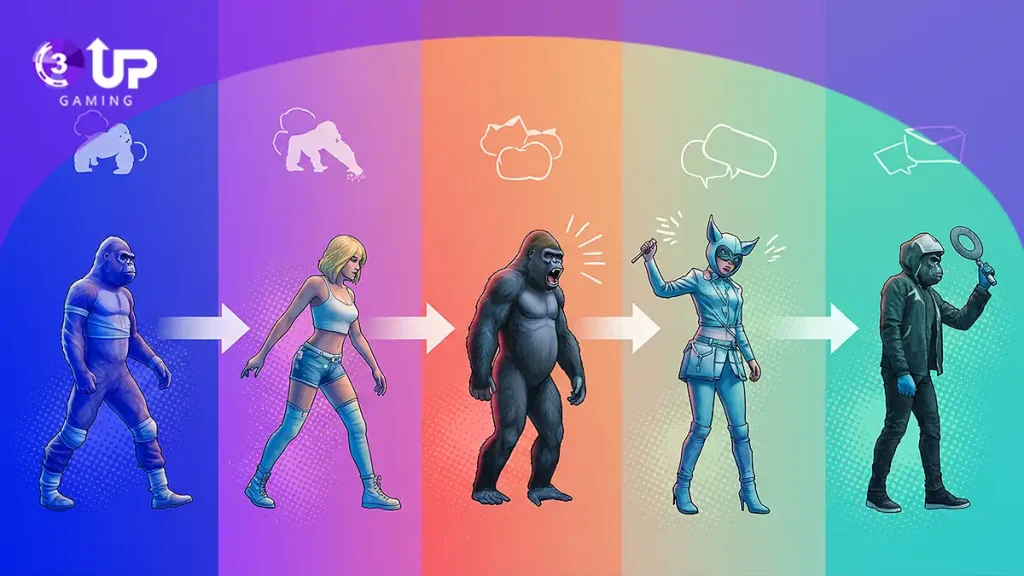
Poker NFT characters are not just online extensions of traditional players; instead, they are the electronically created personalities embodying classic poker stereotypes like the dapper, the eccentric, the stoic, the flamboyant in their sepulchral role.
Gamers use avatars to embody strategy, fashion, and identity in gambling. Avatars’ aspects, like sunglasses and cigars, are represented in items, offering rewards like bonus chips and exclusive tournaments.
The Role of Traits in NFT Value and Rarity
Understanding Trait Hierarchies
In the field of poker NFTs what we see is that not all characteristics are the same. Like in fantasy sports or collector card games some traits are more desirable and thus harder to obtain. Traits may be visual (for example different hat styles, background scenes, animated elements), behavioral (like a tendency to do certain gestures when winning or idling) or functional (for instance which may include energy boosts or buy in reductions).
Here is a go at it: Uncommon, Rare, Epic, and Legendary.
Collectors and players also are drawn in by the idea of having what few others do which in turn fuels emotion and economy based interest in continuous engagement.
Supply, Demand & Visibility
The factors which play into supply, platform excitement cycles, and community interest all influence what we see as rare. In a poker NFT set of 10,000 unique characters may only 100 which have a trait like a neon visor or a glowing cigar and that trait in turn becomes a status symbol.
But also of great importance is visibility. Though high visibility features may not be the rarest in stats they do see their value rise in marketing materials, leaderboards, or on champion avatars. Also what we see is some traits do better than expected because of cultural association or platform support.
This economic aspect turns Poker NFTs into strategic assets. As in the high value poker and NFT trade games players do not base their assessment only on appearance of characters but also on market position, scarcity issues and community opinion.
Don’t miss this: Top 20 Best Poker NFT Characters You Need to Know!
More on that in Behind the Scenes: Poker NFT Gameplay Mechanics!
Top Unique Traits Seen in Poker NFT Characters
Visual, behavioral, and environmental. These elements also appeal to collectors, investors and serious players.
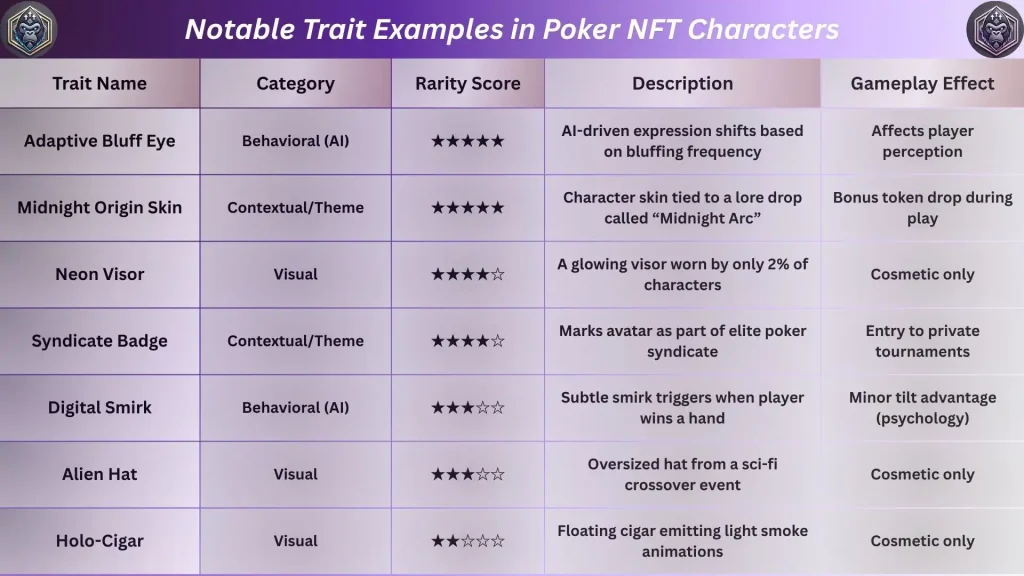
Visual Traits
Poker avatars’ style and flair are the primary which you notice. We think of hats, shades, backgrounds, animated gestures, skin styles, or glowing accessories. What we see first is how they look, these visual traits which include the avatar’s look and feel often determine collectability before we think of what it does.
They also develop community aesthetics which see members form subcultures out of shared styles (e.g. “neon cowboys” or “cyber punks”. Also some very rare visual elements are used in seasonal drops or in collaborations with artists and influencers which in turn increases the prestige of those elements.
Behavioral or AI Traits
A growing and very present category at present includes what we see as behavioral traits which play out in the form of dynamic expressions, reaction animations, or even in-game voice lines.
To make each character seem more alive some platforms are trying out what they may term simple AI personae which see avatars react in the game world by celebrating, insulting, or bluffing.
These see also as avatars that cross the line into that of an agent. A character which has expressive traits is to put forward a certain psychological atmosphere at a table which in turn may be in the case of longer matches or community streams.
Also they may be what you would term algorithmic in response, changing their behavior over time based on player choice or betting style.
Contextual/Theme Traits
These traits are a result of greater narrative design. We see in particular insignia, color schemes or back stories included in the info that a character may be a part of a theme park like an elite poker academy, tech syndicate, or outlaw gang.
Also these context based traits will open up exclusive tournaments, social roles, or access to certain utilities in the system.
Theme traits also include elements of roleplay, guilds, and community building as players align with factions for events, rankings, or seasonal bonuses. They also help in the immersive experience and support longer term character investment.
Boost your game with: How Poker NFT Characters Are Integrated into Web3 Games!
As we covered in: What Is Web3 and How It Redefines Crypto Poker!
Visual Appeal: How Design Affects Desirability
Poker has always included an element of play in which players put on masks to wear off them and also take them off. NFT characters take that to another level with in depth design.
From detailed accessories to symbols which have cultural weight, visual presentation plays a large role in what is desired beyond the base game. Here’s how that plays out:.
Poker Fashion & Flair
In the world of NFTs fashion is a performance art. We see accessories like glowing visors, hats, jackets, jewelry and tattoos which not only serve as decor but also for identity. Players use these to project dominance, allure, mystery or deception at the virtual tables.
Fashion traits often follow archetypes:
- In velvet suits and gold trimmed canes.
- Digital Cowboys in bright neon boots and tech themed bandanas.
- Shrouded in black leather which is lined with glowing ear pieces.
Some traits like the Holo-Cigar or Neon Visor have become icons which you will see in leaderboards, promotional banners, and highlight reels. The more play time a visual feature gets the more it becomes a status symbol in the community.
Iconography and Symbolism
Symbolism which in turn is a form of in-depth design which ties a character into a topic, subculture, or fictional world, goes beyond fashion. We see symbols such as Syndicate Badges, arcane tattoos, or origin marks in which characters are put in touch with background stories and which also open up social recognition.
Designers often embed: Designers put in:
- Color coded to show rarity (eg, gold is for elite, red is for aggressive).
- Cultural symbols (eg, Japanese oni masks, Masonic designs, digital sigils).
- Faction symbols and secret numbers which tie characters into the seasonal story line.
Such symbols point to exclusivity. They are proof of one’s part in a more exclusive or elite section of the game which to some is as valuable as that of rare playing cards to a collector or professional player.
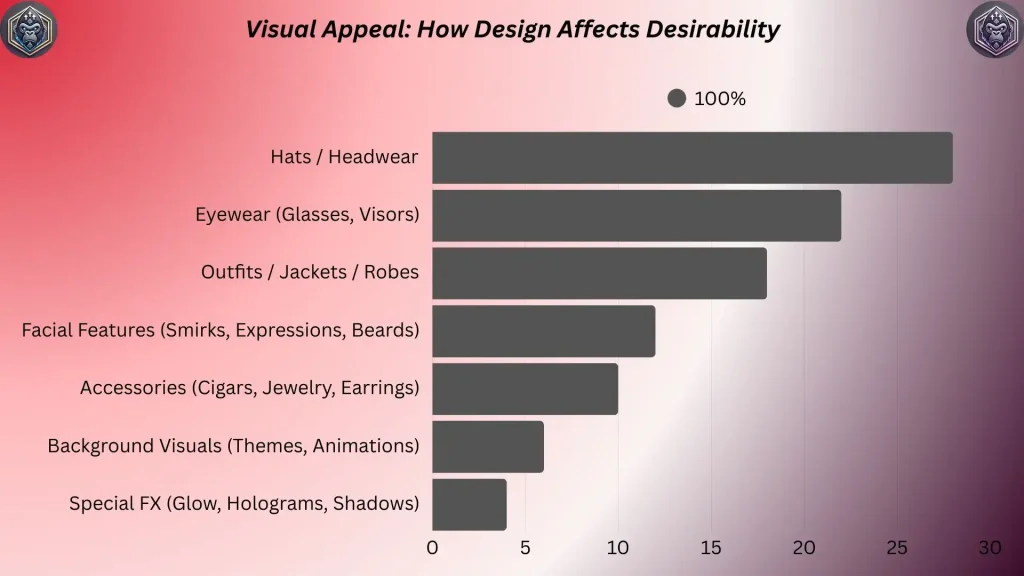
If what we are to note is that there is a common theme which in Poker NFT collections we see to be the appeal, or what it is that generally draws people into this space, some data I put together may present a chart as this:
Utility-Based Traits: Beyond Aesthetics
In contrast with visual and thematic traits that often take the center stage, the real worth of many Poker NFT characters is relatively subdued and is found in their functional, utility-based traits. These attributes enable transformation of characters from mere collectible avatars to active tools in gameplay, interactions within the platform, and ever-changing digital ecosystems.
Let’s have a look at the following table:
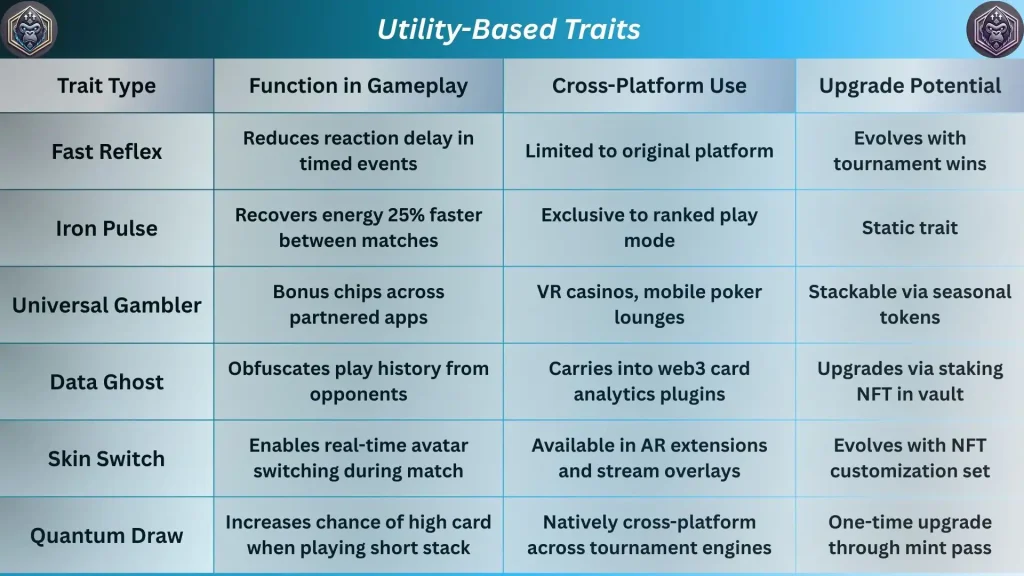
Gameplay Bonuses
With the use of some traits, the value of the character may be enhanced and some advantages attained even outside of aesthetic appeal. Recovery of energy between hands or detection of a slight edge against AI opponents might be altered through various traits, and there might even be triggers that support specific modes like bluff-heavy tournaments or all-in scenarios.
Each of these features propels the creation of counterplay, deepening the level of rarity beyond superficial values. Character Value Enhancement via Traits is what:
- Enhances character value beyond aesthetic appeal.
- Alters energy recovery and AI opponent detection.
- Supports specific modes like tournaments or all-in scenarios.
- Drives creation of counterplay, deepening rarity beyond superficial values.
Gameplay associated utility traits tend to follow certain structures, starting with passive bonuses followed by conditional triggers and shifted to set perks only available in combination with certain environments or card types in the deck at the table.
Some platforms may evolve the gameplay bonus with character leveling or with the introduction of new rules through updates or community voting.
Example: A character Trait owner of “Iron Pulse” might enjoy energy recovery at 25% higher rate during ranked matches as it allows more aggressive bluff chains.
Community-Driven Rarity and Trait Evolution
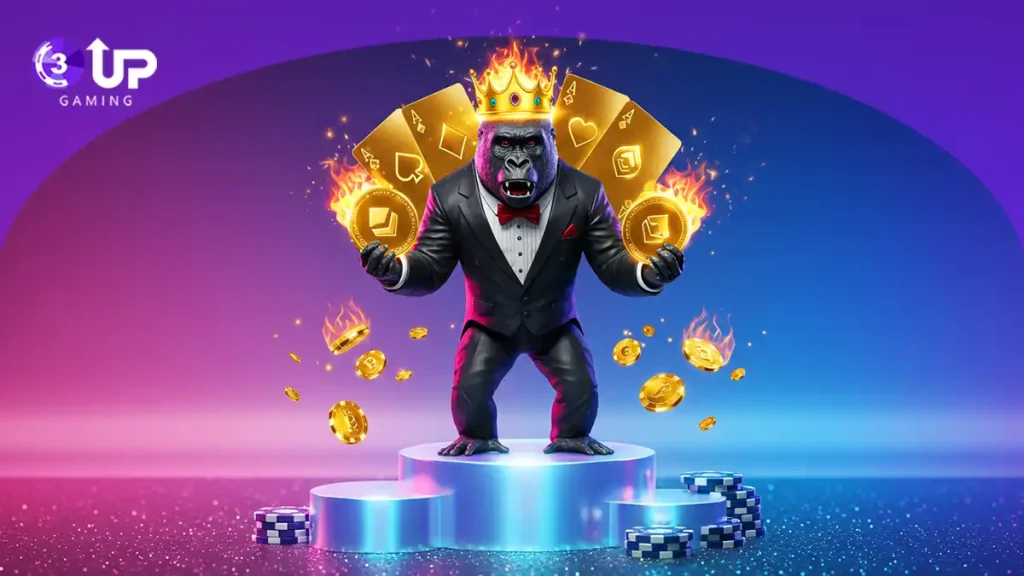
Poker NFT communities do not do well just because of rarity, instead they grow by involving the community in the development of the ecosystem. Today many collections have implemented trait systems which evolve based on user input and collective governance.
DAO Voting
Decentralized Autonomous Organizations (DAOs) see members put forth votes on trait releases, seasonal trait changes, or at times the removal of what is proven to be an unsatisfactory feature. Thus we have a living rarity chart which is a result of strategic agreement and player demand.
User-Influenced Designs
In terms of participation beyond just voting, we see which projects which do very well include the community in the design process. Via contest style submissions, trait customizers, or trait fusion players are able to develop hybrid characters out of existing traits or put forth new ones which in turn ties evolution to player engagement.
Take control with: How Poker NFT Characters Earn You Passive Income!
Want smarter decisions? Why Bitcoin Poker UI Wins Big in 2025!
Real-World Parallels: Poker Culture & NFT Character Design
NFT poker avatars are not isolated; they reflect the style and symbols of the real world poker culture which they in turn present and personify.
Archetypes & Legends
Designs often echo legendary archetypes: The outlaws, the Cold Blooded Killers, the High Rollers, the Tech Wiz underdogs. These archetypes present which until now were recognized at physical tables — and now we see them in virtual play.
Fashion, Faces, Fame
High risk tournaments are known for dramatic players. Hats, sunglasses, and bold suits are status symbols. In the case of NFT characters we see this put into over the top display of reputation, confidence, or unpredictability which before the hand is played is told through visual traits.
How Unique Traits Impact NFT Poker Gameplay
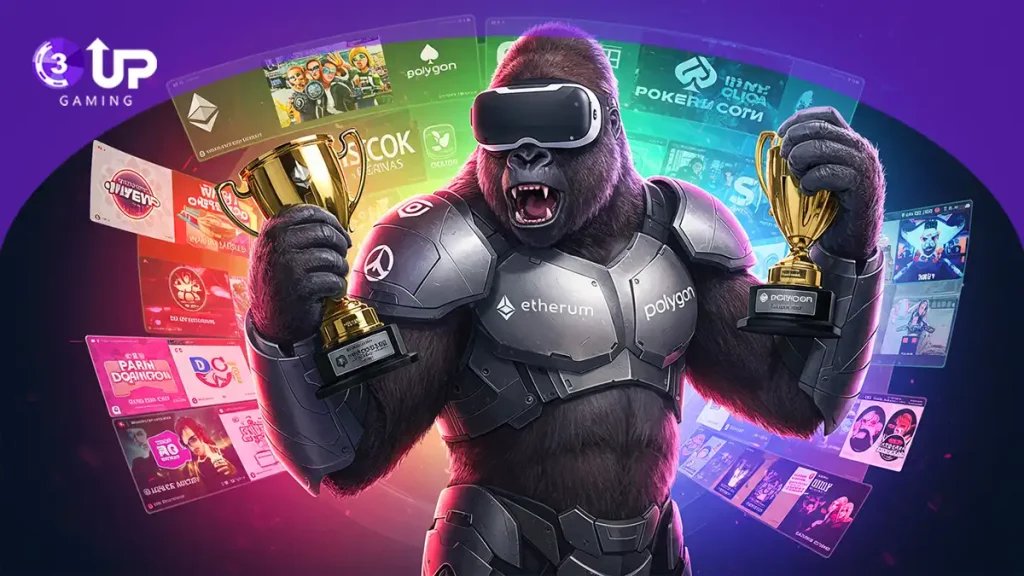
Although there are traits which are just to show many collections instead focus on what we may term as meaningful integration where character traits play a large role in how the game is played and what is at competition.
Matchmaking & Game Dynamics
Some platforms use traits for their match making. We see that players which have aggressive AI traits are put with more defensive bots or other risk based players which in turn creates a chess like metagame. Also trait combinations we see to play with betting windows, bluff detection, or AI behavior.
Strategy Adaptation
As players identify trends in which traits an opponent has, we see the development of adaptive play styles. If a player’s NFT is dominated by bluff features or reaction based perks you may choose to fold early or to lure the other party into your trap. Traits also become a part of your psychological game plan, not just cosmetic.
Traits in the NFT poker space go beyond just aesthetic flair; they are functional elements of a new card meta which blends classic elements with programmed complexity.
Take control with: Secure Bitcoin Poker Sites You Can Trust in 2025!
Sharpen your tactics with: Get the Edge: Top Poker Software Sale [2025]
FAQs about Unique Traits of Poker NFT Characters
1. What makes a poker NFT character unique?
A mix of visual, behavioral, and utility traits which some are fixed and some which evolve, thus each character has their own style, rarity, and gameplay impact.
2. Do traits affect gameplay in poker NFT platforms?
Yes. In some cases traits will give bonuses, play a role in matchmaking, or open up strategic options in more advanced and AI included NFT poker games.
3. Are rare traits more valuable in the NFT market?
For the most part, yes. What we see is that items which have low supply or are exclusive in drop tend to do very well in terms of resell value and prestige among collectors.
4. Can traits be upgraded or evolved over time?
In many environments which see great play. Traits may evolve via game play, community voting, or trait fusion which in turn adds to the dynamic element of rarity.
5. Are poker NFT characters only cosmetic, or do they have real utility?
Many also go beyond visual appeal to include game play benefits, tournament access, staking rewards, or governance roles in poker ecosystems.
6. How do I know if a poker NFT character has rare traits?
Most in the industry report and use rarity statistics and tools. The community’s lists and markets also note which traits have the greatest demand.


